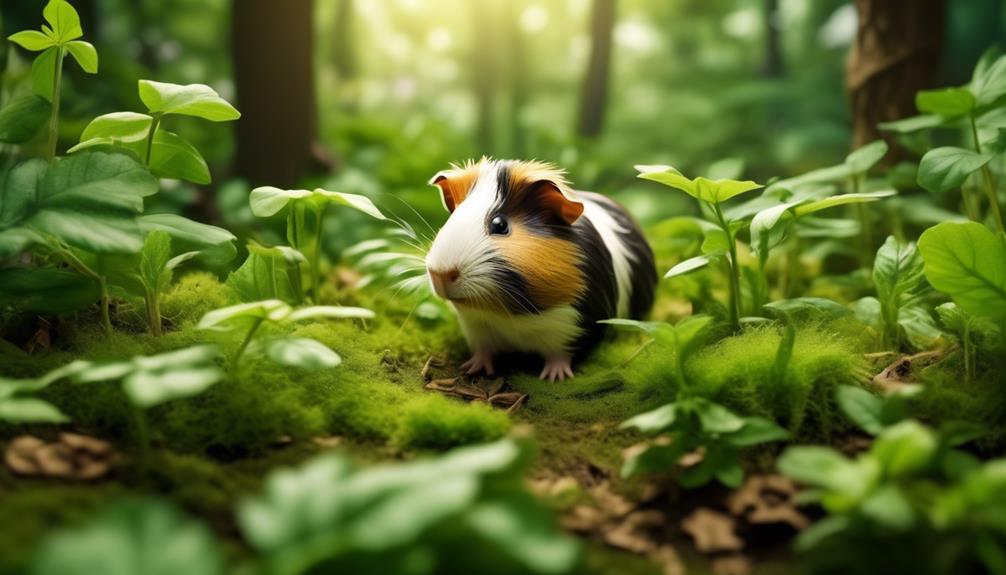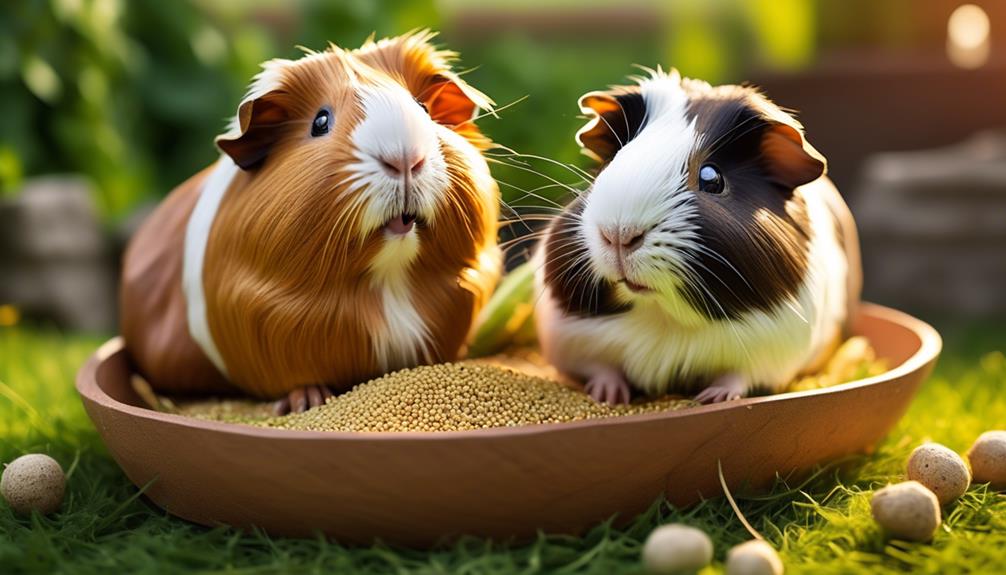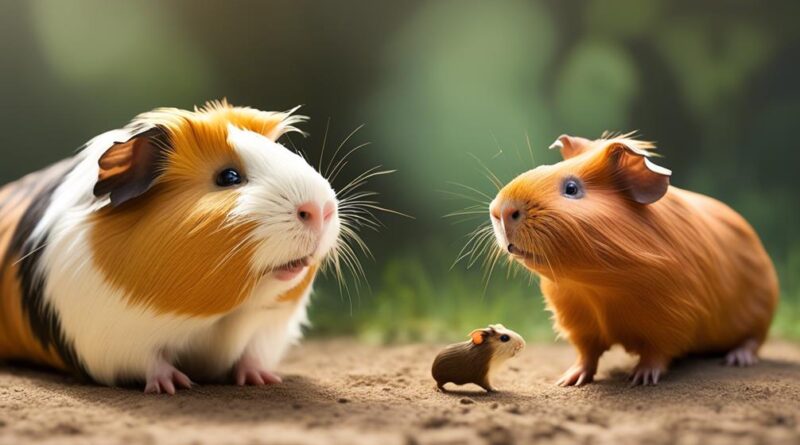4 Best Insights: Captive Vs Wild Guinea Pig Lifespan
If you've ever wondered about the lifespan of guinea pigs in captivity versus their wild counterparts, you're not alone. Understanding the differences between these two environments can provide valuable insights into the factors that influence the longevity of these adorable creatures.
From the impact of diet and nutrition to the risks of predation and natural hazards, exploring the nuances of guinea pig lifespan in captivity and in the wild can shed light on the intricacies of their existence.
So, what are the key considerations that contribute to these disparities?
Guinea Pig Lifespan in Captivity
In captivity, guinea pigs typically live longer than their wild counterparts due to access to consistent food, shelter, and veterinary care. But their lifespan isn't just about the basics. Social interaction and enrichment play a significant role in their overall well-being and longevity.
Guinea pigs are social animals, and in captivity, they thrive when they've the opportunity to interact with other guinea pigs. Having a companion can reduce stress and provide mental stimulation, which can contribute to a longer, healthier life.
Providing adequate space and opportunities for exercise is also crucial. In the wild, guinea pigs have the freedom to roam and explore, so it's essential to mimic this environment in captivity. Access to a larger living area allows for more natural behaviors, such as running, jumping, and exploring, which are all essential for their physical and mental health.
Additionally, providing enrichment activities, such as tunnels, hideouts, and toys, can help keep them mentally engaged and physically active, ultimately contributing to a longer lifespan.
Key Factors Affecting Lifespan in Captivity
Consistent access to proper nutrition and veterinary care significantly impacts the lifespan of guinea pigs in captivity. However, there are other crucial factors within the captive environment that also play a pivotal role in determining the longevity of these small creatures.
Here are three key factors affecting lifespan in captivity:
- Captive Environment: The living conditions within captivity greatly influence a guinea pig's lifespan. Factors such as appropriate cage size, bedding material, and environmental enrichment contribute to their overall well-being. A spacious and clean living area, free from potential hazards, is essential for ensuring a healthy and stress-free life for your guinea pig.
- Nutrition: A balanced diet is fundamental to a guinea pig's health and longevity in captivity. Providing a consistent supply of fresh hay, vegetables, and vitamin C-rich foods is vital for meeting their dietary requirements. Additionally, access to clean, fresh water at all times is indispensable for maintaining their well-being.
- Social Interaction: Guinea pigs are social animals, and companionship significantly impacts their mental and emotional health. Housing them with at least one compatible cage mate can provide them with social stimulation and prevent loneliness, ultimately contributing to a happier and healthier life.
Guinea Pig Lifespan in the Wild

The lifespan of guinea pigs in the wild is influenced by a range of environmental and ecological factors. When comparing the lifespan of wild guinea pigs to their domestic counterparts, it's important to consider the impact of their natural habitat on survival rates.
In the wild, guinea pigs face a variety of challenges that can significantly affect their lifespan. Predation, availability of food and water, competition for resources, and exposure to diseases are all factors that can impact their survival.
In their natural habitat, wild guinea pigs have to fend for themselves, constantly being on the lookout for predators such as birds of prey, foxes, and wild cats. This constant threat of predation can take a toll on their lifespan, as they need to remain vigilant and expend energy on staying safe. Additionally, the availability of food and water sources can fluctuate seasonally, affecting their ability to sustain themselves.
In contrast, domestic guinea pigs are provided with a controlled environment, regular access to food and water, and protection from predators. As a result, they tend to have a longer lifespan compared to their wild counterparts. However, it's essential to ensure that domestic guinea pigs are provided with a balanced diet, regular veterinary care, and a stimulating environment to support their health and well-being.
Understanding the differences in survival challenges between wild and domestic guinea pigs is crucial for providing proper care for these endearing pets.
Environmental Factors Impacting Wild Lifespan
Facing a myriad of challenges, wild guinea pigs must navigate a constantly shifting environment that can significantly impact their lifespan. Habitat diversity plays a crucial role in the wild guinea pig's ability to thrive and survive.
Here are some key environmental factors that influence the lifespan of wild guinea pigs:
- Habitat Diversity: Wild guinea pigs inhabit a wide range of environments, from grasslands to forests. The availability of food sources, hiding spots, and nesting materials varies greatly across these habitats. Access to diverse food options and suitable shelter can directly impact the health and longevity of wild guinea pigs. In environments with limited resources, guinea pigs may face heightened competition for survival, potentially leading to a shorter lifespan.
- Predator Pressure: The presence of natural predators in the wild poses a constant threat to guinea pigs. In response, these small rodents have developed intricate survival strategies, such as intricate burrow systems and vigilant behavior, to evade predation. However, the effectiveness of these strategies can be influenced by the specific habitat and predator dynamics, ultimately affecting the guinea pig's lifespan.
- Climate Variability: Wild guinea pigs are highly adaptable to a range of climates, but extreme weather conditions can pose significant challenges. Severe droughts, floods, or temperature fluctuations can impact the availability of food and water, leading to increased stress and reduced lifespan for wild guinea pigs.
Health and Safety in Captivity
In captivity, ensuring the health and safety of guinea pigs is paramount for their well-being and longevity. Healthcare management plays a crucial role in maintaining their overall well-being. Regular check-ups with a veterinarian, proper grooming, and a balanced diet are essential aspects of healthcare management for captive guinea pigs. It's important to monitor their weight, teeth, and nails to ensure they're in good health. By providing proper healthcare, you can significantly contribute to their lifespan and quality of life.
Environmental enrichment is another key element in ensuring the health and safety of guinea pigs in captivity. Creating a stimulating environment with hiding spots, tunnels, and toys can help prevent boredom and encourage physical activity. Additionally, providing fresh hay, vegetables, and chew toys can help promote dental health and prevent obesity.
Proper bedding and cage maintenance are also vital for their safety and well-being. Regularly cleaning and disinfecting their living space can prevent the spread of diseases and parasites.
Predation and Natural Risks in the Wild
How do guinea pigs in the wild navigate the challenges of predation and natural risks to ensure their survival?
- Predation Risk: In the wild, guinea pigs face constant threats from predators such as foxes, birds of prey, and wild cats. Their small size and lack of natural defenses make them vulnerable to being hunted. To survive, guinea pigs have developed a keen sense of hearing and smell, enabling them to detect predators from a distance. Additionally, they've evolved to be fast runners, allowing them to quickly escape to safety when a threat is detected.
- Natural Hazards: Guinea pigs in the wild also encounter various natural hazards that pose risks to their survival. Harsh weather conditions, including extreme heat and cold, can be challenging for these small animals. To mitigate these risks, wild guinea pigs have adapted to seek shelter in burrows and dense vegetation. These natural shelters provide protection from the elements and serve as hiding spots from predators.
- Social Behavior: Living in groups helps wild guinea pigs enhance their survival chances. They form tight-knit communities where they look out for one another. This social structure allows for increased vigilance against predators, as well as sharing information about food sources and safe areas. By working together, guinea pigs in the wild are better equipped to navigate the challenges of predation and natural risks, ultimately increasing their chances of survival.
Diet and Nutrition in Captivity

Living in captivity, guinea pigs face different challenges, including the need for a carefully balanced diet and proper nutrition to maintain their health and well-being. Meeting their nutritional needs and dietary requirements is essential for their overall health.
In captivity, it's crucial to provide guinea pigs with a diet that mimics their natural intake as closely as possible. The foundation of their diet should consist of high-quality hay, which provides essential fiber to aid in digestion and maintain dental health. Additionally, fresh vegetables such as bell peppers, kale, and carrots are important for meeting their vitamin C requirements.
Guinea pigs can't produce their own vitamin C, so it's vital to supplement their diet with this nutrient to prevent scurvy. Pelleted food specifically formulated for guinea pigs can also be provided, ensuring they receive essential vitamins and minerals. However, it's important to note that these pellets shouldn't be the sole component of their diet, as foraging and chewing on hay are important natural behaviors for guinea pigs.
Fresh water should always be available, preferably in a sipper bottle to prevent contamination. It's crucial to monitor their food intake and ensure they're consuming an adequate amount to prevent obesity or malnourishment.
Foraging and Feeding in the Wild
When guinea pigs are in their natural habitat, they rely on foraging for a variety of grasses, herbs, and other vegetation to meet their dietary needs. This natural feeding behavior is essential for their health and well-being.
In the wild, guinea pigs exhibit the following foraging and feeding habits:
- Grazing: Guinea pigs spend a significant portion of their time grazing on grasses. Their diet consists mainly of various grass species, which provide essential nutrients and fiber necessary for their digestive system to function properly.
- Herbivorous Diet: Wild guinea pigs are herbivores, consuming a wide range of herbs, leaves, and flowers. This diverse diet ensures they receive a variety of essential vitamins and minerals critical for their overall health and immune function.
- Selective Feeding: Guinea pigs display selective feeding behavior in the wild, preferring certain plants over others. This behavior allows them to balance their diet by choosing plants with different nutritional profiles, ensuring they obtain the necessary nutrients for their well-being.
Understanding the natural foraging and feeding habits of wild guinea pigs provides valuable insight into their dietary requirements. When caring for captive guinea pigs, replicating their natural foraging behaviors by providing a variety of grasses, herbs, and leafy greens can contribute to their overall health and well-being.
Frequently Asked Questions
Can Guinea Pigs Be Trained to Increase Their Lifespan in Captivity?
You can definitely increase a guinea pig's lifespan in captivity through proper training methods, environmental enrichment, and exercise routines.
Providing a stimulating environment and engaging in regular play activities can contribute to their health and well-being.
Are There Any Cultural or Traditional Practices in Certain Regions That Affect the Lifespan of Wild Guinea Pigs?
In certain regions, cultural practices and traditional practices can impact the lifespan of wild guinea pigs. Environmental factors and regional influences also play a role.
For example, the availability of food sources and predator prevalence can significantly affect their lifespan. Additionally, certain cultural practices may impact their habitat and access to resources.
Understanding these dynamics is crucial for conservation efforts and ensuring the well-being of wild guinea pig populations.
How Does the Lifespan of Guinea Pigs in Captivity Compare to Other Small Rodent Pets?
In captivity, guinea pigs generally live 4-8 years, similar to other small rodents. They thrive in a captive environment with proper dietary needs met, including hay, fresh veggies, and vitamin C.
Social interaction is key for their well-being, and they require regular exercise to stay healthy. Providing a spacious living area with opportunities for play and exploration is essential.
Meeting these needs can help ensure your guinea pig lives a long and happy life.
Are There Any Specific Genetic Factors That Impact the Lifespan of Guinea Pigs in the Wild?
Genetic influences play a vital role in the lifespan of guinea pigs in the wild. Their ability to survive is shaped by their natural instincts and the presence of natural predators.
In the wild environment, guinea pigs rely on their genetic makeup to evade predators and adapt to changing conditions. These genetic factors have a significant impact on their ability to thrive in the wild and ultimately influence their lifespan.
What Are the Potential Long-Term Health Effects of Certain Types of Bedding and Housing Materials on Captive Guinea Pigs?
When considering the potential long-term health effects of certain types of bedding and housing materials on captive guinea pigs, it's crucial to prioritize their well-being. Some bedding materials may pose a risk of potential respiratory issues.
Additionally, housing conditions, environmental impact, and genetic influence can also impact their lifespan. It's essential to assess these factors and consider regional practices and cultural traditions when providing the best care for captive guinea pigs.
Conclusion
In conclusion, understanding the lifespan differences between captive and wild guinea pigs can help you provide the best care for your pet. Factors like diet, environment, and safety play a significant role in determining lifespan.
By ensuring a safe and healthy environment, and providing proper nutrition, you can help your guinea pig live a longer, happier life in captivity.
Understanding the challenges and risks faced by wild guinea pigs can also give insight into their lifespan in the wild.
